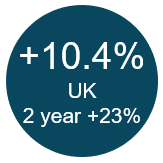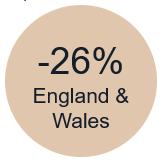More than 104,000 households were in temporary accommodation at the end of March. The highest figure since records began in 1998 and 10% higher than the March 2022 figure. Competition for homes in the private rented sector continues to increase too, with figures from Rightmove showing there were an average of 20 enquiries per rental property in May 2023, up from an average of six in 2019.
With numbers like these few would dispute the need for more homes. Only this week the government has re-asserted its commitment to building one million new homes over the course of this parliament. Yet figures from the NHBC show new homes registrations last quarter were down 42% on a busy Q2 2022 and -7% lower than the Q2 average over the last decade.
In the run up to the general election the challenge for the current administration is to deliver more homes while not alienating voters in Tory strongholds. Building on the greenbelt being one of the areas where political parties seem most divided.
The debate over whether we should be utilising greenbelt land for development is one for another day, but government has made it clear that the focus should be on developing in urban areas or designated city fringe locations.
In a speech by Housing and Levelling Up Secretary Michael Gove, it was announced that the conversion of shops, agricultural buildings, and disused warehouses will be made easier, with greater emphasis placed on redeveloping urban sites rather than building on the greenbelt.
Any plans to encourage development and streamline the planning process should be encouraged, however it is unlikely that these announcements alone will have a significant impact on overall delivery.
Analysis of government net additions data, the latest being for the 2021/2022 financial year, suggests less than 10% of the 232,820 net additional dwellings in England last year were delivered through change of use. Of the 10,300 homes converted through permitted development rights 81% were office to residential conversions with just 591 agricultural to residential and 271 formerly light industrial. Our JLL EMEA Living team discuss the challenges of office to residential conversion in a recent report here.
Urban areas already appear to be pulling their weight. Only 25% of additional dwellings delivered across England last year were in areas classified as rural locations, suggesting urban areas are already delivering the bulk of new supply.
Urban locations see the bulk of housing delivery
The economy
The International Monetary Fund (IMF) has updated its outlook for the UK economy. It expects modest growth of 0.4% in 2023 with a further 1.0% in 2024. But the 2023 figure represents a 0.7 percentage point revision from the 0.3 contraction forecast back in April. UK is expected to outperform Germany this year, the only G7 economy forecast to see output fall, but will lag other advanced economies, which collectively are expected to see the size of their economies increase by 1.5% this year.
Recently weather conditions in the UK have appeared increasingly out of sync with mainland Europe. But there are signs that UK inflation, until recently a clear outlier amongst our European and transatlantic neighbours, is starting to follow their lead.
More positive news on UK inflation will have come as welcome news to most. Particularly those staring down the barrel of rising debt costs.
Inflation figures for June coming in below expectation at 7.9% (predictions were for 8.2%) means the likelihood that bank base rates will have to rise significantly have started to recede. Further falls in inflation, as the impact of higher food and energy costs fall out of the figures, are also expected in the coming months.
Of course, inflation is not the only determining factor behind interest rates. We could still see rates rise, but odds on a 50 basis point rise to 5.5% have fallen. Forecasters, who only a few weeks back were forecasting rates topping out at more than 6.5% are now expecting a softer landing.
In a recent Reuters poll 70% of respondents were expecting the MPC to raise rates to 5.25% on 3 August. A view cemented following the Federal Reserve announcement of a further increase in rates in the US, raising it 25 basis point to hit a 22 year high this week.
The housing market
With the outlook for base rates improving could we have passed to peak for fixed rates? Possibly yes. A handful of lenders have already reduced their rates, with HSBC reducing their fixed rates by up to 0.45 percentage points. The latest figures from mortgage broker Lifetime Capital suggests competitive two-year fixed rates deals at sub 5.9% with five-year rates at 5.4%, based on a 75% LTV.
Land Registry figures suggest a slowing in the rate of growth in prices nationally. UK house prices rose 1.9% in the year to May 2023, down from -3.2% in April. Prices were -2.8% lower nationally than at their peak in September 2022, with London house prices -4.3% lower. Halifax figures for June puts prices down -2.6% annually, with Nationwide reporting -3.5% falls.
High demand for rental properties supports double digit growth
Annual change in achieved rents – year to June 2023
|
Rental properties on the market - Q2 23 compared with Q2 19
|
Rightmove are reporting average asking rents outside London are now 33% higher than they were pre-pandemic in 2019. With rates 28% higher in London. Stock levels are up marginally on 2022 at 7% but remains 42% down on 2019 norms. But it is rental demand where we have seen the highest increase in activity. The average number of enquiries for rented properties nationally having risen to 20, from six pre-pandemic, with the North West seeing enquiries per property rise from seven in May 2019 to 30 in May this year.
High demand is driving rents higher. The Homelet Rental Index reporting average rents on new lets was up 10.4% annually in June. Scotland saw the highest annual increase, with rents on new lets up 15.8%. This reflects the two-tier market between new lets and existing tenancies which has emerged since temporary rent caps were introduced last year.
Despite strong growth in rents landlords still face a number of challenges, which we discussed in our last newsletter. One of which, decarbonisation and the target of EPC C appears to be delayed again. It is being reported that current proposals, which mean new tenancies will be required to have an EPC rating of C or higher by 2025 and all tenancies by 2028, will be delayed. Government citing cost challenges for landlords and the need to overhaul to EPC system.
Latest research from JLL
https://www.jll.co.uk/en/trends-and-insights/research/affordable-housing






